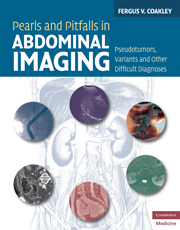Book contents
- Frontmatter
- Contents
- Preface
- Acknowledgements
- Section 1 Diaphragm and adjacent structures
- Section 2 Liver
- Section 3 Biliary system
- Section 4 Spleen
- Section 5 Pancreas
- Section 6 Adrenal glands
- Section 7 Kidneys
- Section 8 Retroperitoneum
- Section 9 Gastrointestinal tract
- Section 10 Peritoneal cavity
- Section 11 Ovaries
- Case 72 Corpus luteum cyst
- Case 73 Peritoneal inclusion cyst
- Case 74 Adnexal pseudotumor due to exophytic uterine fibroid
- Case 75 Malignant transformation of endometrioma
- Case 76 Ovarian transposition
- Case 77 Massive ovarian edema
- Case 78 Decidualized endometrioma
- Section 12 Uterus and vagina
- Section 13 Bladder
- Section 14 Pelvic soft tissues
- Section 15 Groin
- Section 16 Bone
- Index
- References
Case 72 - Corpus luteum cyst
from Section 11 - Ovaries
Published online by Cambridge University Press: 05 November 2011
- Frontmatter
- Contents
- Preface
- Acknowledgements
- Section 1 Diaphragm and adjacent structures
- Section 2 Liver
- Section 3 Biliary system
- Section 4 Spleen
- Section 5 Pancreas
- Section 6 Adrenal glands
- Section 7 Kidneys
- Section 8 Retroperitoneum
- Section 9 Gastrointestinal tract
- Section 10 Peritoneal cavity
- Section 11 Ovaries
- Case 72 Corpus luteum cyst
- Case 73 Peritoneal inclusion cyst
- Case 74 Adnexal pseudotumor due to exophytic uterine fibroid
- Case 75 Malignant transformation of endometrioma
- Case 76 Ovarian transposition
- Case 77 Massive ovarian edema
- Case 78 Decidualized endometrioma
- Section 12 Uterus and vagina
- Section 13 Bladder
- Section 14 Pelvic soft tissues
- Section 15 Groin
- Section 16 Bone
- Index
- References
Summary
Imaging description
Corpus luteum cysts are normal physiologic ovarian structures formed after ovulation by the dominant follicle when the partially collapsed follicular wall becomes vascularized and thickened (these changes in the follicular wall are known as luteinization) [1,2]. Corpus luteum cysts function as endocrine organs, because the luteinized cells secrete estrogens and progesterones in the second half of the menstrual cycle. Corpus luteum cysts are typically seen at ultrasound as 1–3 cm ovarian cysts with echogenic crenulated walls and variable internal low-level echogenicity that may demonstrate dependent layering [3–6]. Doppler insonation demonstrates a characteristic “ring of fire” due to the vascular nature of the cyst wall (Figure 72.1). CT or MRI shows an ovarian cyst with a thick, crenulated, and briskly enhancing wall (Figures 72.2 and 72.3) [7]. Corpus luteum cysts are metabolically active and so may show increased uptake on PET (Figure 72.4). A small amount of physiological free fluid is a common associated finding. Rarely, a large volume of hemoperitoneum may be seen, which presumably reflects rupture with bleeding from the vascular wall of the cyst (Figure 72.5). Such hemorrhagic corpus luteum cysts may occur spontaneously or in patients with bleeding diatheses [8, 9]. Corpus luteum cysts resolve spontaneously at the end of the menstrual cycle. In the event of pregnancy, corpus luteum cysts persist as normal physiological structures up to approximately 14 weeks' gestation (Figure 72.6).
Information
- Type
- Chapter
- Information
- Pearls and Pitfalls in Abdominal ImagingPseudotumors, Variants and Other Difficult Diagnoses, pp. 242 - 247Publisher: Cambridge University PressPrint publication year: 2010
